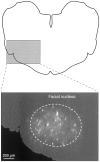Single-cell RT-PCR and functional characterization of Ca2+ channels in motoneurons of the rat facial nucleus
- PMID: 9822718
- PMCID: PMC6793322
- DOI: 10.1523/JNEUROSCI.18-23-09573.1998
Single-cell RT-PCR and functional characterization of Ca2+ channels in motoneurons of the rat facial nucleus
Abstract
Voltage-dependent Ca2+ channels are a major pathway for Ca2+ entry in neurons. We have studied the electrophysiological, pharmacological, and molecular properties of voltage-gated Ca2+ channels in motoneurons of the rat facial nucleus in slices of the brainstem. Most facial motoneurons express both low voltage-activated (LVA) and high voltage-activated (HVA) Ca2+ channel currents. The HVA current is composed of a number of pharmacologically separable components, including 30% of N-type and approximately 5% of L-type. Despite the dominating role of P-type Ca2+ channels in transmitter release at facial motoneuron terminals described in previous studies, these channels were not present in the cell body. Remarkably, most of the HVA current was carried through a new type of Ca2+ channel that is resistant to toxin and dihydropyridine block but distinct from the R-type currents described in other neurons. Using reverse transcription followed by PCR amplification (RT-PCR) with a powerful set of primers designed to amplify all HVA subtypes of the alpha1-subunit, we identified a highly heterogeneous expression pattern of Ca2+ channel alpha1-subunit mRNA in individual neurons consistent with the Ca2+ current components found in the cell bodies and axon terminals. We detected mRNA for alpha1A in 86% of neurons, alpha1B in 59%, alpha1C in 18%, alpha1D in 18%, and alpha1E in 59%. Either alpha1A or alpha1B mRNAs (or both) were present in all neurons, together with various other alpha1-subunit mRNAs. The most frequently occurring combination was alpha1A with alpha1B and alpha1E. Taken together, these results demonstrate that the Ca2+ channel pattern found in facial motoneurons is highly distinct from that found in other brainstem motoneurons.
Figures









References
-
- Catterall WA. Structure and function of voltage-gated ion channels. Annu Rev Biochem. 1995;64:493–531. - PubMed
-
- Chin H, Krall M, Kim H-L, Kozak CA, Mock B. The gene for the α1 subunit of the skeletal muscle dihydropyridine-sensitive calcium channel (Cchl1a3) maps to mouse chromosome 1. Genomics. 1992;14:1089–1091. - PubMed
-
- Dunlap K, Luebke JI, Turner TJ. Exocytotic Ca2+ channels in mammalian central neurons. Trends Neurosci. 1995;18:89–98. - PubMed
-
- Edwards FA, Konnerth A, Sakmann B, Takahashi T. A thin slice preparation for patch clamp recordings from neurones of the mammalian central nervous system. Pflügers Arch. 1989;414:600–612. - PubMed
Publication types
MeSH terms
Substances
LinkOut - more resources
Full Text Sources
Miscellaneous
